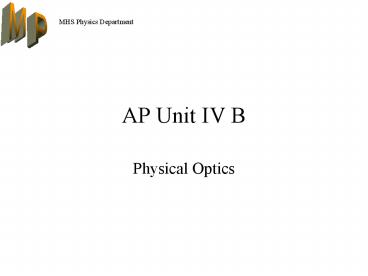AP Unit IV B - PowerPoint PPT Presentation
1 / 13
Title: AP Unit IV B
1
AP Unit IV B
- Physical Optics
2
1. Interference and Diffraction
- Students should understand the interference and
diffraction of waves so they can - a) Apply the principles of interference to
coherent sources in order to (1) Describe the
conditions under which the waves reaching an
observation point from two or more sources will
all interfere constructively, or under which the
waves from two sources will interfere
destructively. - (2) Determine locations of interference maxima or
minima for two sources or determine the
frequencies or wavelengths that can lead to
constructive or destructive interference at a
certain point. - (3) Relate the amplitude produced by two or more
sources that interfere constructively to the
amplitude and intensity produced by a single
source.
3
- b) Apply the principles of interference and
diffraction to waves that pass through a single
or double slit or through a diffraction grating,
so they can (1) Sketch or identify the intensity
pattern that results when monochromatic waves
pass through a single slit and fall on a distant
screen, and describe how this pattern will change
if the slit width or the wavelength of the waves
is changed. - (2) Calculate, for a single-slit pattern, the
angles or the positions on a distant screen where
the intensity is zero. ?? (3) Sketch or identify
the intensity pattern that results when
monochromatic waves pass through a double slit,
and identify which features of the pattern result
from single-slit diffraction and which from
two-slit interference. ?? (4) Calculate, for a
two-slit interference pattern, the angles or the
positions on a distant screen at which intensity
maxima or minima occur. ?? (5) Describe or
identify the interference pattern formed by a
diffraction grating, calculate the location of
intensity maxima, and explain qualitatively why a
multiple-slit grating is better than a two-slit
grating for making accurate
4
- c) Apply the principles of interference to light
reflected by thin films, so they can (1) State
under what conditions a phase reversal occurs
when light is reflected from the interface
between two media of different indices of
refraction. ?? (2) Determine whether rays of
monochromatic light reflected perpendicularly
from two such interfaces will interfere
constructively or destructively, and thereby
account for Newtons rings and similar phenomena,
and explain how glass may be coated to minimize
reflection of visible light. ??
5
- 2. Dispersion of light and the electromagnetic
spectrum Students should understand dispersion
and the electromagnetic spectrum, so they can a)
Relate a variation of index of refraction with
frequency to a variation in refraction. ?? b)
Know the names associated with electromagnetic
radiation and be able to arrange in order of
increasing wavelength the following visible
light of various colors, ultraviolet light,
infrared light, radio waves, x-rays, and gamma
rays.
6
Constructive and destructive interference
- Principle of superposition add the two waves
together - Constructive interference Destructive
Interference
7
Single slit diffraction
- When waves pass through a single slit they spread
out like ripples from a pond. This is called
diffraction. If the slit is wide enough, waves
from the top of the slit will destructively
interfere with waves from the middle of the slit
when m?/2 d/2 sin ? or m? d sin ?
d
?
8
Youngs double slit experiment
- With two slits better interference fringes can be
observed. Constructive interference occurs when d
sin ? m?. Since sin ? tan ? y/L for small
angles then m? d y/L or y/L m?/d
AP Equation xm m?L/d
9
Diffraction Grating
For constructive interference m? d sin ?
10
Thin film interference
Occurs when thickness 2t ?n/2 ?/2n , t ?/4n
11
Dispersion forming a spectrum
http//cse.ssl.berkeley.edu/img/em_prism.gif
12
Electromagnetic Spectrum
http//www.yorku.ca/eye/spectrum.gif
13
Polarization of Light
OML Oscillating Magnetic lines































